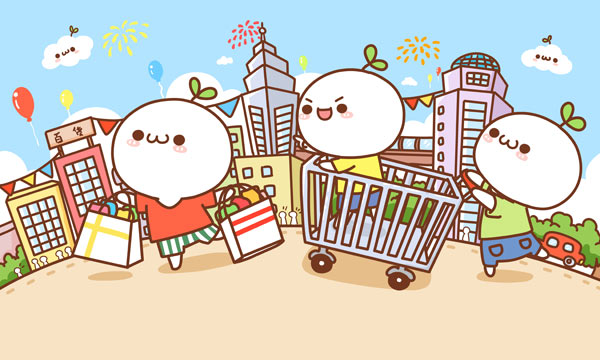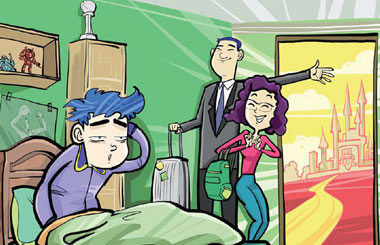The people behind the funny faces
Updated: 2016-04-30 03:04
By Deng Zhangyu(China Daily)
|
|||||||||
 |
|
These emojis created by an art student were downloaded by 4 million users in one day. PROVIDED TO CHINA DAILY |
Instant messaging and other realms of cyberspace are giving new opportunities to a load of talented people
Three years ago, when Liu Jingjing posted on Sina Weibo, China's version of Twitter, a white cartoon image of a chubby figure with a tuft of grass on its head, it is unlikely she imagined just how popular it would become. So popular in fact that millions of people use it each day, making it one of the most popular emojis on China's instant messaging services.
Liu, 21, a second-year student at an art college in Shanxi province, works for a Beijing company, 12 Buildings, as a part-time cartoonist. A recent series of 16 emoticons Liu has designed for the social instant messaging app WeChat, based on that chubby character with grass on its head, was unveiled on March 12 and was downloaded by four million users that day.
WeChat users have used Liu's previous series of emoticons of the same cartoon image with different facial expressions and body gestures more than five billion times in four months. It means that almost half the Chinese population are using Liu's emoticons while messaging their friends.
"The number is stunning," said Wang Biao, founder of 12 Buildings. "But that's what's happening in China — cartoonists are gaining instant fame by designing emoji."
Most of the cartoonists who design emoji are not paid for their use, but many hope that the financial rewards will begin to flow after their works gain exposure and they can start selling them to individual users in other forms such as books and companies that use their cartoon images for marketing.
Those who are passionate about emoji range from professional artists to part-time designers to amateur doodlers, all riding a wave of popularity that has washed over China's social networks and instant messaging platforms for several years. It seems that designing emoji of cartoon images has become a must-do for some cartoonists who want to gain wide public recognition in China.
WeChat's department responsible for emoji says it has the works of 3,000 artists on file, and emoticons are now so commonly used that even the less popular ones can become widely known very quickly.
Wang says his company has about 20 cartoonists, among whom half are college students. All were born in the Internet era, so, Wang says, "they're very sensitive to new things online. They can creatively weave them into their emoticons."
The way in which 12 Buildings' cartoonists work is similar to that practiced in Japan's cartoon industry. The cartoonist designs the image and others help manage it, so they can update stories or bring new series of emojis online very quickly.
Independent operators
However, in China most cartoonists run their images independently. Zhong Wei, 32, a full-time cartoonist in Shenyang, Liaoning province, draws cartoon images and since 2014 has published two picture books.
He created a human-like white cat that behaves in a mean but comic way and after turning it into an emoji, it has received wide recognition. Before the cat was created, he drew cartoon images of a human-like bear, a man with a chicken head and a little boy for a children's book.
"Chinese Internet users draw on emoticons mainly to express emotions that they can't express unaided," Zhong says.
To express crying there is a while cat that can laugh even as it sheds tears, cries as it lies in a pool of tears, cries while clapping its hands and cries as it covers its face with its paws.
The emoji of his white cat has attracted many instant messaging app users in less than a year. Three series of the cat emojis have been downloaded a total of about 200 million times since they were launched in August, and Zhong now has about 500,000 followers on Weibo.
Each of his series of white cat emojis has been targeted at different users, he says, for the romantically inclined, for those on diets and for those wanting to extend thanks to anyone giving them money in digital red envelopes.
"Good emoji must be absolutely adorable or cheekily naughty," Zhong says. "Their expressions must be very vivid and the body language rich."
Those who use his emoticons predominantly range from those in their teens to the middle-aged. The obsession of Chinese with emoji has its roots in the kawaii (cute) and otaku (those who are social outcasts because of their obsession with something, often comics) cultures of Japan, he says.
"We don't go to parties or hang out with friends as often as Westerners do. Instead, Chinese communicate with friends using instant messaging. We're open and talkative in the online world. But we turn in on ourselves and are less expressive in the real world."
Embarrassing moments
Shi Donglin, originator of Freezing Gal, a cartoon image she created in college, says using emojis helps bring light relief at embarrassing moments during communication.
"If I want to ask my boyfriend to buy a bag for me I can use a coquettish emoji instead of having to resort to cold words," says Shi, 23.
Her cartoon figure, with dark skin and a ponytail, is based on her experience in college, she says, and is popular among college students.
Unlike traditional cartoonists who generally have to create an image first, then sell comic stories to magazines or publishing houses and finally go online to win wider acceptance, Shi went straight to Weibo and was surprised at how much attention it gained in such a short time that she turned it into an emoji for messaging apps such as QQ and WeChat, thus giving it much wider currency.
Apart from continuing to produce more emojis based on Freezing Gal, she has started to draw picture books to build on the character's image.
Xu Han, the cartoonist behind Ali the red fox, perhaps the most popular fox in China, says: "The problem with the Internet era is that while a cartoon image can gain huge exposure and many fans very quickly, people can also forget a cartoon image easily."
Three million copies of Xu's picture books featuring Ali, which he created in high school, have been sold since 2009.
His emoji of the red fox was one of the first cartoon images launched on QQ in 2012 and WeChat in 2015. The problem Xu talks of worries many other cartoonists, especially those who are looking to make a name for themselves by creating cartoon emojis.
"Weibo and WeChat give good exposure to cartoonists than do traditional publishing channels," Xu says. "But if you want to cultivate a good cartoon image brand you need more than emoji."Short attention spans
Wang of 12 Buildings says that although it is hard in an era of short attention spans to give longevity to cartoon characters, Internet exposure creates chances for young cartoonists to work with big brands that earlier would never have employed domestic cartoonists to design images for them.
The chubby white creature with a tuft of grass on its head has been drafted to work with the US multinational consumer goods company Procter & Gamble, and Freezing Gal is now being used in advertising the Chinese smartphone brand Xiaomi, popular with students.
"China never lacked good cartoonists," Wang says. "It just lacked ways to promote its brands. Emojis are giving it the chance to do that in an effective way."
Contact the writer at @chinadaily.com.cn
Related Stories
Chinese emoji a double-edged sword in office communication 2016-04-20 09:14
Cartoonist thrives on Internet 2013-07-15 07:11
Emoji express emotions mere words cannot match 2015-11-23 16:41
12th China Int'l Cartoon & Animation Festival kicks off in Hangzhou 2016-04-28 09:42
Cartoon and animation show held in Yinchuan 2016-04-10 10:24
Today's Top News
Running the world
Getting back to basics
Alibaba denies reported takeover of AC Milan
China stresses Putin's expected visit
Russia launches rocket from Vostochny Cosmodrome
Record number of Chinese exhibitors at Spanish expo
Beijing least affordable city in the world to rent
US accused of 'hyping up' military flights
Hot Topics
Lunar probe , China growth forecasts, Emission rules get tougher, China seen through 'colored lens', International board,
Editor's Picks

|

|

|

|

|

|







